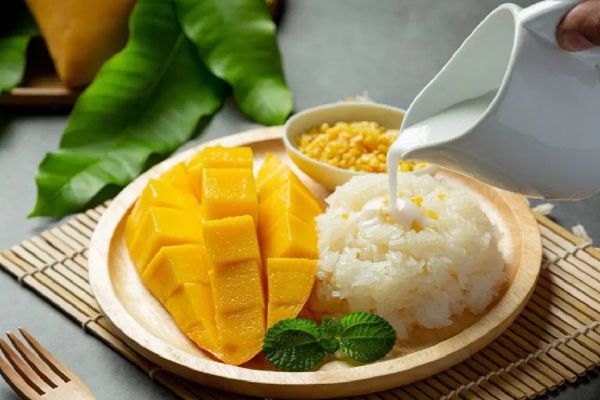
When it comes to Thai desserts, few are as iconic and universally adored as Mango Sticky Rice, known locally as Khao Niew Mamuang (ข้าวเหนียวมะม่วง). This delightful combination of sweet glutinous rice, rich coconut milk, and ripe mango slices offers a harmonious blend of textures and flavors that epitomize Thai culinary artistry.
A Brief History
Mango Sticky Rice has deep roots in Thai culture, with its origins tracing back to the late Ayutthaya period (1351–1767). Historical records from this era mention the enjoyment of sweet dishes, including combinations of sticky rice and mangoes. The dessert gained widespread popularity during King Chulalongkorn’s reign (Rama V), becoming a staple in Thai households and street food stalls alike.
Key Ingredients
-
Glutinous Rice (Sticky Rice): The foundation of the dish, glutinous rice is soaked, steamed, and then mixed with sweetened coconut milk to achieve its signature sticky texture.
-
Coconut Milk: Freshly extracted coconut milk is sweetened and sometimes lightly salted, then combined with the cooked rice to infuse it with rich flavor.
-
Ripe Mangoes: Varieties like Nam Dok Mai and Ok Rong are preferred for their sweetness and smooth texture, complementing the creamy rice perfectly.
-
Optional Toppings: Toasted mung beans or sesame seeds are often sprinkled on top for added crunch and visual appeal.
Preparation Overview
Soaking the Rice: Glutinous rice is soaked in water for several hours or overnight to ensure even cooking.
Steaming: The soaked rice is then steamed until tender.
Coconut Mixture: While the rice steams, a mixture of coconut milk, sugar, and a pinch of salt is heated until the sugar dissolves.
Combining: The hot coconut mixture is poured over the steamed rice, allowing it to absorb the flavors as it rests.
Serving: The coconut-infused sticky rice is served alongside slices of ripe mango, with an additional drizzle of coconut sauce and optional toppings.
Regional Variations
While Thailand is the birthplace of Mango Sticky Rice, variations of the dish can be found across Southeast Asia:
-
Cambodia: Known as Bay Domneib, the dessert is similar in preparation, often featuring a slightly saltier coconut sauce.
-
Laos: Sticky rice is a staple, and during mango season, it’s common to enjoy it with fresh mango slices and a sprinkle of sesame seeds.
-
Malaysia: In regions like Kelantan, Pulut Mangga is a popular treat, reflecting the shared culinary traditions with southern Thailand.
-
Philippines: A similar dish called Puto Maya pairs sticky rice with mangoes and is traditionally enjoyed with hot chocolate.
Seasonality and Availability
In Thailand, Mango Sticky Rice is especially popular during the mango season, which typically spans from March to May. During this time, the dessert is ubiquitous, available from street vendors to high-end restaurants. However, with the global availability of mangoes and glutinous rice, it’s now enjoyed year-round in many parts of the world.
Cultural Significance
Beyond its delightful taste, Mango Sticky Rice holds a special place in Thai culture. It’s a symbol of hospitality and is often served during festivals and family gatherings. The dessert’s popularity has even led to international recognition, with efforts to have it acknowledged by UNESCO as part of Thailand’s intangible cultural heritage.
Final Thoughts
Mango Sticky Rice is more than just a dessert; it’s a culinary experience that captures the essence of Thai culture—balance, harmony, and a celebration of natural flavors. Whether you’re enjoying it on a bustling street in Bangkok or recreating it in your kitchen, this dish offers a sweet escape into the heart of Thailand.
The post appeared first on .









